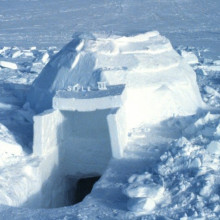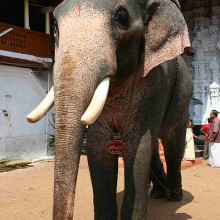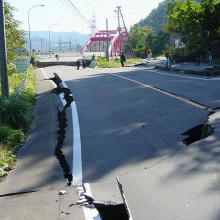In this NewsFlash, we explore how laser sensitive nanoparticles can help to identify tumours, what the genome of a 4000 year old man reveals about human migrations and the physics of a jogging elephant! Plus, we find out what seismologists can learn from the recent earthquake in Haiti.
In this episode

00:11 - Nanoparticles and a sonic signature pick up blood-borne cancers
Nanoparticles and a sonic signature pick up blood-borne cancers
Scientists have developed a new way to detect cancer cells in blood using laser-sensitive magnetic nanoparticles.
Cancer occurs when cells in the body mutate, causing them to lose their normal growth inhibitions and divide rapidly.
 This can cause a localised accumulation of cells called a tumour; in the wrong place this can be fatal in itself, but more normally the really dangerous aspect of cancer is when it sheds cells that take up residence in other parts of the body in a process called metastasis.
This can cause a localised accumulation of cells called a tumour; in the wrong place this can be fatal in itself, but more normally the really dangerous aspect of cancer is when it sheds cells that take up residence in other parts of the body in a process called metastasis.
It would be very useful to detect these cells as soon as they get into the bloodstream, but there may be only a few thousand of them in the blood at any one time, so the amount of blood you would have to screen would be impracticle.
But now Ekaterina Galanzha and collegues have come up with an interesting solution to this problem. First they inject tiny magnetic particles which are chemically attached to a molecule that docks with a receptor carried by many types of cancer cell. This means that any cancer cells present ultimately become covered with magnetic particles.
Then, by placing a large magnet adjacent to a blood vessel, the magnetically-decorated cancer cells accumulate along the side of the vessel; the longer the magnet is there there more cells accumulate.
To detect and quantify them, pulses of laser light are fired into the blood vessel. This is absorbed preferntially by the particles, causing them to heat up, which creates a detectable sound. The louder it is, the more cancer cells there must be present.
Any nanoparticles not attached to cancer cells tend to get washed away by the blood flow, but to increase the specificity of the assay the researchers also added a second set of nanoparticles, these ones consisting of miniature gold rod structures, which stick to a different receptor on the cancer cells. They also respond to a different wavelength of laser light, meaning that if both particles are present the you can be reasonably sure that a genuine cancer cell has been detected.
The technique has successfully detected cancer cells in experimental mice, and the results seem to tally with the cell counts seen in the animals, suggesting that the same approach could have practical and diagnostic uses in humans.

03:06 - Genome sequence of 4000 year old human
Genome sequence of 4000 year old human
Scientists have  decoded the genome sequence of an ancient human who lived 4000 years ago using hair samples recovered from the permafrost at an archaeological site in Greenland.
decoded the genome sequence of an ancient human who lived 4000 years ago using hair samples recovered from the permafrost at an archaeological site in Greenland.
The DNA code reveals that the individual was male, had brown eyes, wiry black hair, dark skin, short stature, dry earwax and a tendency to baldness!
The work, published in Nature and carried out by University of Copenhagen researcher Eske Willerslev and his colleagues, reveals some intriguing details about how humans got to be in that part of the world and when.
The brought the man's characteristics to life by analysing the ancient DNA for sequences called SNPs (single nucleotide polymorphisms), which are like genetic signposts pointing to the presence of certain appearance traits.
By comparing the SNP pattern from the ancient man with SNPs carried by present-day populations known to have certain characteristics, it was possible to discover what this person would have looked like and where on Earth he and his tribe arose.
Most existing theories suggested that the Saqqaq people, to whom this man belonged, were migrants from neighbouring native American or Inuit populations. Instead, what the analysis shows is that this ancient eskimo is related to neither; he was actually from somewhere in Siberia.
This suggests that there must have been a significant, and much more recent, migration from Siberia across the Bering Strait, over North America and into Greenland about 5000 years ago.
Understanding how humans evolved and populated the globe by which routes and over what times is an open book; this new study shows that when the power of modern genetics is brought to bear upon the problem great leaps forward in our understanding are possible.

05:55 - Do elephants run, trot or just walk rapidly?
Do elephants run, trot or just walk rapidly?
This sounds like an obvious question, but what do we actually mean by running? One definition is that all of an animal's legs leave the ground at once, which is obvious when humans are running, but the same happens when a dog or horse runs. In this case an elephant definitely doesn't run as it always has a leg on the ground, but when the elephant is moving fast it does look more dynamic than a walk so what is going on?
 A slightly more sophisticated definition is that when you are walking your total amount of kinetic and gravitational potential energy is about constant, so if your centre of mass moves up you slow down and vice versa, but if you are running energy is stored in springy tendons in your legs and your total kinetic and potential energy goes up and down.
A slightly more sophisticated definition is that when you are walking your total amount of kinetic and gravitational potential energy is about constant, so if your centre of mass moves up you slow down and vice versa, but if you are running energy is stored in springy tendons in your legs and your total kinetic and potential energy goes up and down.
Norman Heglund from belgium has tried to investigate this in elepants, by going to an elephant sanctuary in Thailand and then building a large elephant proof track which measures the forces the elephant is applying to the ground - which involves some quite serious engineering.
They have found that elephants sort of run. Their front legs bounce in a running manner, but their back legs walk in a smooth manner. It is like elephants are almost running but are too heavy to do it properly. Not that this would make a lot of difference if you are facing a charging 4 tonne elephant of course.

08:53 - Solar Dynamics Observatory
Solar Dynamics Observatory
The sun is the source of over 99.9% of the energy arriving at the surface of the Earth and it is a very active place with giant solar flares and complex weather. This weather can hurl giant lumps of plasma called coronal mass ejections out into the solar system, knocking out power systems and satellites over 80 million miles away on Earth. Plus, we are just starting to understand the ways solar weather can affect the weather on earth.
 On Thursday, NASA launced a new satellite called the Solar Dynamics Observatory designed to view the sun continuously at higher resolution, and at a higher rate than ever before, take a spectrum of the sun more than every 10 seconds and measure the magnetic field on the surface of the sun continuously.
On Thursday, NASA launced a new satellite called the Solar Dynamics Observatory designed to view the sun continuously at higher resolution, and at a higher rate than ever before, take a spectrum of the sun more than every 10 seconds and measure the magnetic field on the surface of the sun continuously.
This is going to produce a huge amount of data - about 1.5 terrabytes every day which needs a network connection of over 150Mbit/second. This means it has to be in a geostationary orbit over its basestation in America so it can keep transmitting all the time.
Hopefully it will let us get a much better understanding of the sun and its affects on the Earth.

10:54 - Secrets of a sea turtle's first steps
Secrets of a sea turtle's first steps
If you've ever tried running along a beach on soft, dry sand, you'll how much hard work  it can be; the grains of sand shifting beneath your feet slow you down and make it more likely you will slip and fall over. Sea turtles know only too well the perils of sandy beaches. After they hatch, baby turtles emerge from their nests and run the gamut of the beach, down to the waves. Even though they only spend a few brief moments on land, baby turtles can move with remarkable speed across sand even if it is loose and slippery. The question is: how do they do it?It turns out that newborn turtles use their flippers to produce small blocks of compact sand, which act like a solid allowing the turtles to propel themselves rapidly across the beach surface. These findings are published in the journal Biology Letters by Daniel Goldman and colleagues from the Georgia Institute of Technology in the US.Last year, Goldman and his team built a creature called SandBot, a simple robotic creature that helped them understand how real animals cope with walking across soft sand. The researchers found they had to carefully adjust the movements and timing of Sandbot's six legs in order to get it to walk across rather than swim inefficiently through the sand.Turning their attention to turtles, the team went down to the beach at Jekyll Island, armed with a mobile laboratory to work with the Georgia Sea Turtle centre. Together they took high-speed film of hatchling leatherback turtles crawling along a trackway covered either with loosely packed sand or sand paper to mimic hard ground.The researchers were very careful not to disturb the turtles too much, only taking 5 animals from each nest, and only trying three runs for each animal before releasing them back onto the same spot they were taken from.It came as a surprise to see that the turtles dealt equally well with the solid surface or the loose sand, crawling along at similar speeds on both, but employing two different techniques. The turtles' flippers gripped into the sandpaper using a small claw. When they were on sand something else was going on: high speed film revealed that the flippers pushed into the sand at precisely the right angle and force to build up blocks of compacted sand which they then push against, generating thrust to move forwards.It goes to show how animals can evolve elegant biomechanical solutions for the physical problems that the natural world throws at them. To build a robot that can walk across sand requires intricate laboratory experiments. Meanwhile turtles have arrived - without having to think about it - at their own way of getting themselves from nest to sea, and back again, a mode of transport that scientists are just beginning to understand.
it can be; the grains of sand shifting beneath your feet slow you down and make it more likely you will slip and fall over. Sea turtles know only too well the perils of sandy beaches. After they hatch, baby turtles emerge from their nests and run the gamut of the beach, down to the waves. Even though they only spend a few brief moments on land, baby turtles can move with remarkable speed across sand even if it is loose and slippery. The question is: how do they do it?It turns out that newborn turtles use their flippers to produce small blocks of compact sand, which act like a solid allowing the turtles to propel themselves rapidly across the beach surface. These findings are published in the journal Biology Letters by Daniel Goldman and colleagues from the Georgia Institute of Technology in the US.Last year, Goldman and his team built a creature called SandBot, a simple robotic creature that helped them understand how real animals cope with walking across soft sand. The researchers found they had to carefully adjust the movements and timing of Sandbot's six legs in order to get it to walk across rather than swim inefficiently through the sand.Turning their attention to turtles, the team went down to the beach at Jekyll Island, armed with a mobile laboratory to work with the Georgia Sea Turtle centre. Together they took high-speed film of hatchling leatherback turtles crawling along a trackway covered either with loosely packed sand or sand paper to mimic hard ground.The researchers were very careful not to disturb the turtles too much, only taking 5 animals from each nest, and only trying three runs for each animal before releasing them back onto the same spot they were taken from.It came as a surprise to see that the turtles dealt equally well with the solid surface or the loose sand, crawling along at similar speeds on both, but employing two different techniques. The turtles' flippers gripped into the sandpaper using a small claw. When they were on sand something else was going on: high speed film revealed that the flippers pushed into the sand at precisely the right angle and force to build up blocks of compacted sand which they then push against, generating thrust to move forwards.It goes to show how animals can evolve elegant biomechanical solutions for the physical problems that the natural world throws at them. To build a robot that can walk across sand requires intricate laboratory experiments. Meanwhile turtles have arrived - without having to think about it - at their own way of getting themselves from nest to sea, and back again, a mode of transport that scientists are just beginning to understand.

13:29 - What can satellites reveal about earthquakes?
What can satellites reveal about earthquakes?
Professor James Jackson, Cambridge University
Chris - Now a few weeks on from what happened in Haiti, the whole situation there is still making news because of the sheer scale of the devastation. But what about the actual earthquake itself? What are scientists beginning to learn from observing the land as it now is following the quake. Well, James Jackson is professor of active tectonics at Cambridge University and he's with us. Hello James.
James - Hello.
Chris - Welcome to The Naked Scientists. Tell us a little bit, if you can, about how scientists are now beginning to follow-up what's happened in Haiti to try to understand more about what caused it in the first place and what's likely to come in the future.
James - We have a range of tricks now we can use to really do a forensic job on what happens in earthquakes, wherever they are. Some are space-based techniques, one of which is called radar interferometry. What we use here are satellites, which pass over the earth and send a radar beam down on the surface of the earth and it reflects back to the satellite. This is similar to the way people are used to hearing about how radar can monitor aeroplanes or ships look for other ships at sea by sending a beam out and measuring how long it takes to come back, which tells you how far away that object is.
What these satellites do is pass over the planet's surface. They take an image of the ground before the earthquake and then take another image of the ground after the earthquake. You can then compare the two and see how the ground has moved. We can do this now fairly regularly over most of the land surface of the earth and we can measure how much the ground has moved to an accuracy of a few centimetres. Maybe that sounds a lot or little to you - a few centimetres - but the actual signal in the earthquake - the  amount the ground moves - is between 2 and 5 metres. So the signal to noise ratio is fantastic; it's very easy to see this. There are various problems with it of course. The satellite itself is in a polar orbit, which means it orbits from north to south and the Earth rotates underneath it. So the satellite makes a track across the earth and every time it goes around, the earth has spun around a little bit more so it makes the track over a different place. So the satellite only repeats over the same track about every 30 or 40 days or something of that sort.
amount the ground moves - is between 2 and 5 metres. So the signal to noise ratio is fantastic; it's very easy to see this. There are various problems with it of course. The satellite itself is in a polar orbit, which means it orbits from north to south and the Earth rotates underneath it. So the satellite makes a track across the earth and every time it goes around, the earth has spun around a little bit more so it makes the track over a different place. So the satellite only repeats over the same track about every 30 or 40 days or something of that sort.
Chris - Which is why we've seen this little delay between the earthquake happening and now we're getting the data.
James - Yes, the data is now coming through. But not all satellites are the same. There's another effect we have to watch out for which is these satellites were not designed to do this. So the satellites which are up there were mostly designed to monitor the sea surface, because what you can monitor very easily and accurately is the height of the sea surface anywhere and that is how you monitor things like the El Niño, the big weather effects, which are the real reason for putting those satellites up there. So they were designed to look at the oceans and you have a particular optimal wavelength for doing that, which is about 5 centimetres. That's actually not very good for land because it scatters off things which are about 5 centimetres in size like leaves on trees. And places  like Hispaniola - and most of the Caribbean - is covered in jungle, so that's not very good. So there's another satellite, which uses a longer wavelength of about 15 centimetres. This is good, it sees through trees. But it doesn't repeat quite as often as the other ones, so we have had to wait quite a long time to get the data from this. But we now have some images of Hispaniola.
like Hispaniola - and most of the Caribbean - is covered in jungle, so that's not very good. So there's another satellite, which uses a longer wavelength of about 15 centimetres. This is good, it sees through trees. But it doesn't repeat quite as often as the other ones, so we have had to wait quite a long time to get the data from this. But we now have some images of Hispaniola.
Chris - What is this showing and what can we learn from it? Are our initial suspicions about what happened actually correct on the basis of what these satellites are revealing?
James - Yes, because there are also other ways we can get [the same informaton]. We also have seismology, which is the sound that comes out of the earthquake, to see what's happened and we can also use GPS, which is the precise movement of points on the ground. It's the same technology used for sat-navs in cars, but rather more precise. So these things combined together are very much more powerful than each one on its own.
Chris - What are they revealing?
James - They're revealing the length of the fault which moved, how much it moved, where it moved most, what's the distribution of slip along that fault, and how's the ground moved as a response to that earthquake. What you see is that the ground moves. It moves up and down, and sideways: a few metres in this earthquake - but if it does it hundreds of times in hundreds of earthquakes, it produces a landscape. And so what you learn about is the relation between the landscape and the way these faults move. And then you can recognize signals in the landscape which tell you about these faults before they move. So you can actually go to a place and say, "Yes. I know why the land looks like that because I've seen it before somewhere else." And that is what saves lives. It's that step which is now fairly routine in places like California and Japan, which allows the engineers to know what they're up against and design things that don't fall down.
Chris - One snag of course is that everywhere on earth is different or, you could argue, everywhere is unique to a certain extent and what goes for Haiti may not necessarily go elsewhere. So there will be a degree of geographic specificity, won't there? And therefore, you need to have a long term data set I suppose, in order to get close to understanding how that bit of the Earth's surface performs and behaves.
James - The circumstances are different. So Haiti is covered in jungle, Iran's covered in desert, which is much easier to see things. The way the faults move are not very different because they're obeying pretty basic laws of physics, which we understand at that level. We understand what happens if you move a fault that size and in the way it moved. It may be hard to see the signals in the landscape because they're not preserved in places that rain very heavily or are covered in ice or snow or so on. It's harder to see than in a desert. So, that's why we do these things all the time because you're right, you build up a databank of experience essentially, where you see bits of the story in some places, but you recognise the bits you can't see because actually, you've seen them somewhere else.










Comments
Add a comment